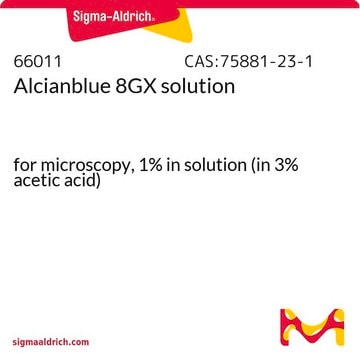05500
Alcian Blue 8GX
for microscopy (Bact., Bot., Hist.)
Synonym(s):
Alcian Blue, Ingrain Blue 1
About This Item
Recommended Products
grade
for microscopy (Bact., Bot., Hist.)
Quality Level
form
powder
solubility
methanol: water (1:1): 0.01 g/10 mL, blue to very deep blue
εmax
≥60 at 605-625 nm in water
application(s)
diagnostic assay manufacturing
hematology
histology
storage temp.
room temp
SMILES string
[Cl-].[Cl-].[Cl-].[Cl-].CN(C)C(\SCc1ccc2c3nc(nc4n5[Cu]n6c(nc7nc(nc5c8cc(CS\C(N(C)C)=[N+](\C)C)ccc48)c9ccc(CS\C(N(C)C)=[N+](\C)C)cc79)c%10ccc(CS\C(N(C)C)=[N+](\C)C)cc%10c6n3)c2c1)=[N+](/C)C
InChI
1S/C56H68N16S4.4ClH.Cu/c1-65(2)53(66(3)4)73-29-33-17-21-37-41(25-33)49-57-45(37)62-50-43-27-35(31-75-55(69(9)10)70(11)12)19-23-39(43)47(59-50)64-52-44-28-36(32-76-56(71(13)14)72(15)16)20-24-40(44)48(60-52)63-51-42-26-34(18-22-38(42)46(58-51)61-49)30-74-54(67(5)6)68(7)8;;;;;/h17-28H,29-32H2,1-16H3;4*1H;/q+2;;;;;+2/p-4
InChI key
CKLBXIYTBHXJEH-UHFFFAOYSA-J
Looking for similar products? Visit Product Comparison Guide
Related Categories
General description
Application
- Alcian Blue 8GX is generally used for the demonstration of mucopolysaccharides and as a general microscopic stain.
- It is a heteroglycan stain for neutral, sulfated, and phosphated mucopolysaccharides and glycosaminoglycans in tissues such as cartilage and extracellular matrices.
- It has been used to discover novel insights into the short-term impact of food-relevant synthetic amorphous silica on the intestinal epithelium.
- It is suitable for amyloid staining, cystine following oxidation, and staining mast cells in polychromatic alcian blue-safranine methods.
- It is applicable as a microscopic stain for the detection of bacterial capsules, and mucin staining of cytological fine-needle aspirates.
Biochem/physiol Actions
Features and Benefits
- Desired staining patterns can be obtained by manipulating pH and salt concentrations.
Principle
Storage Class Code
11 - Combustible Solids
WGK
WGK 3
Flash Point(F)
Not applicable
Flash Point(C)
Not applicable
Personal Protective Equipment
Certificates of Analysis (COA)
Search for Certificates of Analysis (COA) by entering the products Lot/Batch Number. Lot and Batch Numbers can be found on a product’s label following the words ‘Lot’ or ‘Batch’.
Already Own This Product?
Find documentation for the products that you have recently purchased in the Document Library.
Customers Also Viewed
Our team of scientists has experience in all areas of research including Life Science, Material Science, Chemical Synthesis, Chromatography, Analytical and many others.
Contact Technical Service










